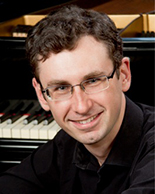February 9 – Well Tempered Clavier Book II
By Bonnie Garrett, Reed College

On February 9th, in the midst of a Portland ice storm, Ilya Poletaev played the Well Tempered Clavier Book II at Reed College. Poletaev’s career includes the modern piano (2010 winner of the prestigious Johann Sebas-tian Bach Competition in Leipzig) as well as the fortepiano and harpsichord (he has studied harpsichord with Colin Tilney). The concert was well worth braving the weather. A group of about 60 attended, mostly “Reedies,” and they were spellbound to hear so much Bach. I’m certain they will always remember this concert.
Ilya chose to use our double harpsichord and fortepiano for the first half and the modern piano for the second half. This, of course, gave me pause, to have three instruments at different pitches and in different temperaments. The stars were beautifully aligned, however, as we tuned the harpsichord up to 416. The fortepiano hit an all-time low, hovering around 420. It is usually kept at 430 and rarely do we let it go below 427. But, due to the low humidity, cold weather, new building, etc. it had slipped to 420 and that made Ilya very happy. So he in fact split up some of the pairs, moving from harpsichord to fortepiano or vice versa and it was not jarring. He played the sets in ascending half-steps rather than the circle of fifths or another grouping. He is a fine Bach player and I was pleasantly surprised to hear how he handled the early keyboards. . . . very well.
In the first half, Ilya used the fortepiano for the following: Prelude and Fugue in C# minor; Fugue in D minor; Fugue in D# minor; Prelude in E major; Prelude in F major; Prelude in F minor. The rest were played on the harpsichord, with the lute stop used for the Prelude in E-flat major.
What was jarring was to transition to the modern piano for the second half. I had some difficulty and needed to focus intently on the music, not on the instrument. Ilya used lots of pedal. . . not injudiciously, though. He doesn’t consider the piano a resonant instrument compared to the early keyboards. During the question & answer period after the performance, he addressed some good questions from the students, including the use of pedal; he uses pedal to enhance resonance, rather than to create legato lines which is very interesting. Also, he really championed the historic instruments and the need to be informed about historic practice. He played with lots of color, bringing out lines and shaping exquisitely. Interestingly, he hummed (not in tune) on the second half but not the first half. . . maybe he was in the zone with the modern piano or maybe he was adding to the resonance.
See the following for more information:
Ilya Poletaev:
http://astralartists.org/our-artists/current-roster/ilya-poletaevpiano/
Bonnie Garrett:
http://academic.reed.edu/music/instructors/Garrett-B.html
The Early Keyboard Collection at Reed: http://academic.reed.edu/music/keyboards/
